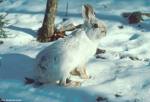
Site author Richard Steane
The BioTopics website gives access to interactive resource material, developed to support the
learning and teaching of Biology at a variety of levels.

Site author Richard Steane
|
The BioTopics website gives access to interactive resource material, developed to support the
learning and teaching of Biology at a variety of levels.
|
|

 MacLulich published some classical information in 1937. This population data was obtained from records of lynx and snowshoe hare populations as evidenced by numbers of skins caught by trappers from 1845 onwards. It is especially clear-cut as snowshoe hare are the main prey of Canadian lynx, and there is no other significant predator involved.
It would be a useful exercise to use a spreadsheet to convert this extracted data into a graph (data at base of table).
MacLulich published some classical information in 1937. This population data was obtained from records of lynx and snowshoe hare populations as evidenced by numbers of skins caught by trappers from 1845 onwards. It is especially clear-cut as snowshoe hare are the main prey of Canadian lynx, and there is no other significant predator involved.
It would be a useful exercise to use a spreadsheet to convert this extracted data into a graph (data at base of table).
| Time elapsed years |
Population of snowshoe hare (thousands) |
Population of lynx (hundreds) |
| 0 | 20 | 10 |
| 2 | 55 | 15 |
| 4 | 65 | 55 |
| 6 | 95 | 60 |
| 8 | 55 | 20 |
| 10 | 5 | 15 |
| 12 | 15 | 10 |
| 14 | 50 | 60 |
| 16 | 75 | 60 |
| 18 | 20 | 10 |
| 20 | 25 | 5 |
| 22 | 50 | 25 |
| 24 | 70 | 40 |
| 26 | 30 | 25 |
| 28 | 15 | 5 |
| Above data in excel format | bare data | |